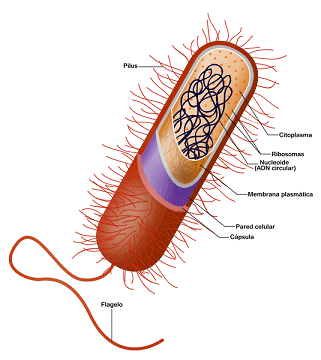Prokaryotic cell
The main characteristic of prokaryotes is that they do not have a nucleus. Bacteria are prokaryotic organisms. They have DNA, but it is not surrounded by a nuclear membrane.
The fundamental structure of the prokaryotic cell is:
- DNA that is not surrounded by a nuclear membrane is free and dispersed in the cytoplasm, in a region called the nucleoid. The DNA forms a bacterial chromosome that contains all the genetic information necessary for the cell. The information contained in the DNA will be copied to RNA and will reach the ribosomes , which will synthesize the corresponding protein.
- They lack membranous organelles: they have no mitochondria, no chloroplasts , no Golgi apparatus, no endoplasmic reticulum, etc.
- They have ribosomes, nonmembranous organelles, with which they make proteins.
- The plasma membrane is surrounded by a cell wall.
- They have no cytoskeleton or intracellular mobility.
- Its size is smaller than that of eukaryotic cells, it is similar to that of mitochondria and chloroplasts. In higher courses we will see that the origin of these organelles is in ancient prokaryotic cells.
- Prokaryotic cells do not form multicellular organisms.
